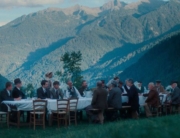![]() Fresh coming-of-age tales are difficult to make for the simple reason that they’re produced constantly. Finding a new angle is difficult and in the case of Hide Your Smiling Faces, it’s achieved through seeming simplicity. There’s very little editing and most of the action happens within single, well-composed frames. The plot is pared down and often the camera focuses on seemingly insignificant details. For instance, there’s an extended shot of a main character playing with a scab on his leg. It’s the keenly observed details that elevate the film and truly capture boyhood. Aided by stunningly verdant cinematography, the film has a somber, dreamlike quality and for those who appreciate its deliberate pace, you’ll be rewarded.
Fresh coming-of-age tales are difficult to make for the simple reason that they’re produced constantly. Finding a new angle is difficult and in the case of Hide Your Smiling Faces, it’s achieved through seeming simplicity. There’s very little editing and most of the action happens within single, well-composed frames. The plot is pared down and often the camera focuses on seemingly insignificant details. For instance, there’s an extended shot of a main character playing with a scab on his leg. It’s the keenly observed details that elevate the film and truly capture boyhood. Aided by stunningly verdant cinematography, the film has a somber, dreamlike quality and for those who appreciate its deliberate pace, you’ll be rewarded.
Set during a summer in a very rural section of New Jersey, two young brothers struggle with boredom, competition with other boys, and the death of a friend. Slightly built, nine-year-old Tommy (Ryan Jones) looks up to his bigger brother Eric (Nathan Varnson), a stoic but caring 14-year-old. They do what most boys do—riding bikes, playing in the woods, challenging each other—but death always seems to be looming. Their friend’s death weighs heavily on them, and another boy tests Eric’s friendship by threatening to commit suicide. Competition also surrounds them, mostly in the form of regular, informal wrestling matches out in the grassy fields. No one seems particularly happy, but the two brothers have each other to depend on.
Relative newcomers, actors Ryan Jones and Nathan Varnson give full, realistic performances. Varnson as Eric is more self-control and capable. Jones as Tommy is vulnerable, but far from helpless. Many of the scenes feel improvised and capture daily play and discovery—from wandering around an abandoned house to playing with a dead bird. First-time director Daniel Patrick Carbone focuses on small moments, making them far more meaningful than we initially imagined. He also establishes the tone, that of a dream with fragmented impressions, which perhaps is closer to how our memories operate than in a more traditional narrative. Like a dream, the film, rife with exploration, washes over you, reminding you of how tenuous and fragile life can be.







Leave A Comment